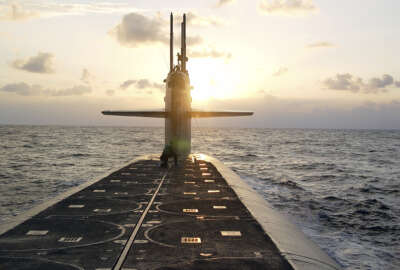
DoD’s modernization efforts ballooned by Air Force upgrades, study says
The Air Force's modernization plans account for a large part of the Defense Department's overall spending to bring weapon systems up to date over the next decade,...
The Defense Department has the Air Force to thank for a large part of its bump in modernization expenditures over the next decade-and-a-half, according to Defense budget analysts.
A new study from the Center for Strategic and International Studies (CSIS) found the Air Force’s modernization plans are the largest contributors to the Defense Department’s modernization bill.
The Air Force’s modernization budget is expected to grow by 73 percent from about $19 billion in fiscal 2015 to about $33 billion at its peak in 2023. The costs will then even out to about $25 billion per year around 2028.
“Most of the bow wave is actually coming from the Air Force and that’s a bit surprising,” said CSIS Senior Fellow Todd Harrison during the Jan. 27 report launch in Washington. “The real driver within the Air Force’s modernization bow wave is aircraft.”
The Air Force is investing in four new aircraft: the long range strike bomber, the F-35A, the KC-46A and the T-X Advanced Pilot Trainer, all of which are ramping up spending.
These modernization efforts are part of a larger “bow wave” of debts DoD is racking up as it moves off many of its aging weapons systems.
“A modernization bow wave typically forms as the overall Defense budget declines and modernization programs are delayed or stretched into the future. As this happens, the underlying assumption is that funding will become available to cover these deferred costs,” the study stated.
DoD has more than 120 major acquisition programs currently in process or planned to start during the next 10 years.
The overall increase will mean DoD will spend about $90 billion per year at its peak in 2022.
But while the Air Force’s modernization plans are taking up more of the overall debts as the bow wave hits, the Navy and Marine Corps will be drawing down their modernization expenditures, CSIS forecasted.
“Current plans for Navy and Marine Corps modernization do not indicate a significant bow wave of programs. Instead, these plans project a significant decline in funding over the next 15 years that counteracts some of the growth in the other services’ modernization plans,” the study stated.
The Navy and Marine Corps are expected to spend between $34 billion and $36 billion between 2016 and 2022. However, just as the Air Force bow wave starts to hit, the Navy and Marine modernization budget is expected to take a steep decline to about $31 billion in 2024, and eventually to about $25 billion in 2030.
The decline is due to several programs ending their planned procurements, such as the V-22 Osprey and the MH-60R Seahawk helicopter.
The Army’s modernization plans seem small compared to the other two services. The Army is planning to spend about $9.5 billion at its peak in the early 2020s and then will decline to about $4.5 billion a year in 2030, CSIS estimated.
Harrison was quick to warn, however, that cost overruns are a persistent problem with modernization programs.
A 2008 RAND Corporation study found that defense acquisitions had an average cost growth of 57 percent while in development and 34 percent in procurement.
“This is not looking good, right? You go back to that modernization bow wave, and you project in just typical cost overrun growth here and it’s going to increase it significantly,” Harrison said.
Those overruns are usually caused by errors in the original cost estimate, Harrison said.
Harrison said the peak of the cost modernization bow wave probably won’t change because DoD has a tendency to stretch out the cost overruns overtime.
Budget talk
While the modernization budget looks into the future, Harrison said in the short term he will be watching the 2017 Defense budget for how DoD deals with economic and efficiency assumptions. The White House is expected to send President Barack Obama’s budget to Congress on Feb. 9.
“DoD has proposed a number of efficiency initiatives and they have been banking these savings and already spending them in other parts of the budget,” Harrison said. “Some of these savings have come true and some haven’t and so when I look at the budget I see a budget that is already highly leveraged on these efficiency savings.”
Along with efficiency assumptions, DoD also makes economic assumptions for things like fuel prices and inflation. If those are wrong it can change parts of the budget down the road.
Another area to watch, Harrison said, is the capability versus capacity issue.
“It’s a difference in priority and your view of where the competition is headed in the future,” Harrison said in a December interview with Federal News Radio. “Capacity helps you more today, it helps you with the kind of challenges and threats that we are facing today, and the real demand on the Navy right now is to be in more places than they can cover.”
That issue came to a head when Defense Secretary Ash Carter scolded Navy Secretary Ray Mabus on the Navy’s 2017 spending priorities. The letter directed the Navy to spend less on building ships and more on building capabilities.
Copyright © 2025 Federal News Network. All rights reserved. This website is not intended for users located within the European Economic Area.
Scott Maucione is a defense reporter for Federal News Network and reports on human capital, workforce and the Defense Department at-large.
Follow @smaucioneWFED




